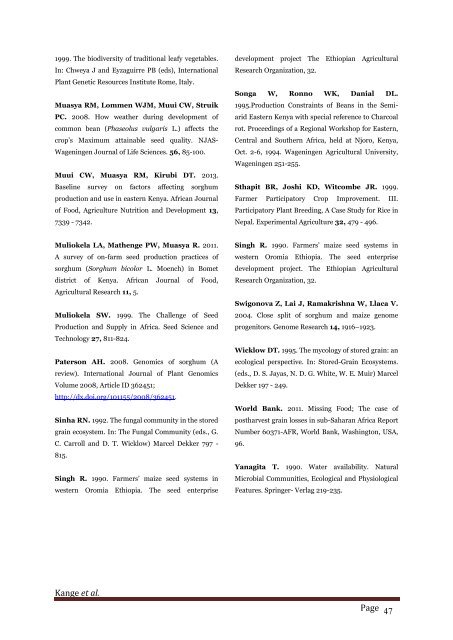Pre- and post harvest factors affecting sorghum production (Sorghum bicolor L. Moench) among smallholder farming communities
A farm survey was conducted on Sorghum (Sorghum bicolor L. Moench) as a staple cereal crop adapted in arid and semi – arid lands. The objective was to determine pre - and post - harvest factors affecting sorghum production. Ninety five farmers were sampled using snowballing sampling method in six sorghum growing sub –counties (Siaya, Bondo, Njoro, Rongai, Kibwezi and Kathonzweni) to gather information on pre - and post – harvest. Data collected on source of sorghum seeds, varieties storage form and were analyzed using descriptive statistic cross tabulation SPSS version 20 software. Sources of sorghum seed were farmers own seed (33.7%), from neighbour or market (24.2%) and farm input distributors (42.1%). The results showed that 44.2% and 55.8% of the farmers preferred local and improved sorghum varieties respectively. Sorghum grains were either stored in shelled form (88.4%) or on panicles (11.6%). This study further established that farmers maintain a diversity of sorghum landraces unique in their adaptation, food quality, grain yield and quality of harvested products resistance. The results of this study can be used to explain the perennial food insecurity in these regions known to have huge potential for sorghum production. http://www.innspub.net/volume-5-number-4-october-2014-ijaar/
A farm survey was conducted on Sorghum (Sorghum bicolor L. Moench) as a staple cereal crop adapted in arid and semi – arid lands. The objective was to determine pre - and post - harvest factors affecting sorghum
production. Ninety five farmers were sampled using snowballing sampling method in six sorghum growing sub –counties (Siaya, Bondo, Njoro, Rongai, Kibwezi and Kathonzweni) to gather information on pre - and post – harvest. Data collected on source of sorghum seeds, varieties storage form and were analyzed using descriptive statistic cross tabulation SPSS version 20 software. Sources of sorghum seed were farmers own seed (33.7%),
from neighbour or market (24.2%) and farm input distributors (42.1%). The results showed that 44.2% and 55.8% of the farmers preferred local and improved sorghum varieties respectively. Sorghum grains were either
stored in shelled form (88.4%) or on panicles (11.6%). This study further established that farmers maintain a diversity of sorghum landraces unique in their adaptation, food quality, grain yield and quality of harvested
products resistance. The results of this study can be used to explain the perennial food insecurity in these regions known to have huge potential for sorghum production.
http://www.innspub.net/volume-5-number-4-october-2014-ijaar/
Create successful ePaper yourself
Turn your PDF publications into a flip-book with our unique Google optimized e-Paper software.
1999. The biodiversity of traditional leafy vegetables.<br />
In: Chweya J <strong>and</strong> Eyzaguirre PB (eds), International<br />
Plant Genetic Resources Institute Rome, Italy.<br />
Muasya RM, Lommen WJM, Muui CW, Struik<br />
PC. 2008. How weather during development of<br />
common bean (Phaseolus vulgaris L.) affects the<br />
crop’s Maximum attainable seed quality. NJAS-<br />
Wageningen Journal of Life Sciences. 56, 85-100.<br />
Muui CW, Muasya RM, Kirubi DT. 2013.<br />
Baseline survey on <strong>factors</strong> <strong>affecting</strong> <strong>sorghum</strong><br />
<strong>production</strong> <strong>and</strong> use in eastern Kenya. African Journal<br />
of Food, Agriculture Nutrition <strong>and</strong> Development 13,<br />
7339 - 7342.<br />
development project The Ethiopian Agricultural<br />
Research Organization, 32.<br />
Songa W, Ronno WK, Danial DL.<br />
1995.Production Constraints of Beans in the Semiarid<br />
Eastern Kenya with special reference to Charcoal<br />
rot. Proceedings of a Regional Workshop for Eastern,<br />
Central <strong>and</strong> Southern Africa, held at Njoro, Kenya,<br />
Oct. 2-6, 1994. Wageningen Agricultural University,<br />
Wageningen 251-255.<br />
Sthapit BR, Joshi KD, Witcombe JR. 1999.<br />
Farmer Participatory Crop Improvement. III.<br />
Participatory Plant Breeding, A Case Study for Rice in<br />
Nepal. Experimental Agriculture 32, 479 - 496.<br />
Muliokela LA, Mathenge PW, Muasya R. 2011.<br />
A survey of on-farm seed <strong>production</strong> practices of<br />
<strong>sorghum</strong> (<strong>Sorghum</strong> <strong>bicolor</strong> L. <strong>Moench</strong>) in Bomet<br />
district of Kenya. African Journal of Food,<br />
Agricultural Research 11, 5.<br />
Muliokela SW. 1999. The Challenge of Seed<br />
Production <strong>and</strong> Supply in Africa. Seed Science <strong>and</strong><br />
Technology 27, 811-824.<br />
Paterson AH. 2008. Genomics of <strong>sorghum</strong> (A<br />
review). International Journal of Plant Genomics<br />
Volume 2008, Article ID 362451;<br />
http://dx.doi.org/101155/2008/362451.<br />
Sinha RN. 1992. The fungal community in the stored<br />
grain ecosystem. In: The Fungal Community (eds., G.<br />
C. Carroll <strong>and</strong> D. T. Wicklow) Marcel Dekker 797 -<br />
815.<br />
Singh R. 1990. Farmers’ maize seed systems in<br />
western Oromia Ethiopia. The seed enterprise<br />
Singh R. 1990. Farmers’ maize seed systems in<br />
western Oromia Ethiopia. The seed enterprise<br />
development project. The Ethiopian Agricultural<br />
Research Organization, 32.<br />
Swigonova Z, Lai J, Ramakrishna W, Llaca V.<br />
2004. Close split of <strong>sorghum</strong> <strong>and</strong> maize genome<br />
progenitors. Genome Research 14, 1916–1923.<br />
Wicklow DT. 1995. The mycology of stored grain: an<br />
ecological perspective. In: Stored-Grain Ecosystems.<br />
(eds., D. S. Jayas, N. D. G. White, W. E. Muir) Marcel<br />
Dekker 197 - 249.<br />
World Bank. 2011. Missing Food; The case of<br />
<strong>post</strong><strong>harvest</strong> grain losses in sub-Saharan Africa Report<br />
Number 60371-AFR, World Bank, Washington, USA,<br />
96.<br />
Yanagita T. 1990. Water availability. Natural<br />
Microbial Communities, Ecological <strong>and</strong> Physiological<br />
Features. Springer- Verlag 219-235.<br />
Kange et al.<br />
Page 47


















